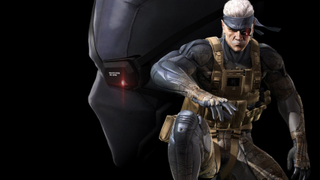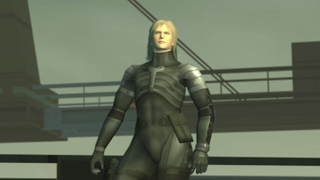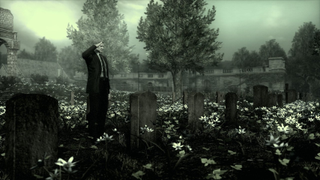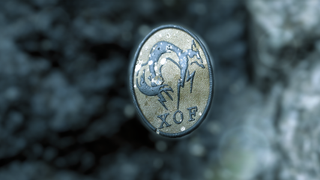The A-Z of Hideo Kojima

Warning! This page contains spoilers for Metal Gear Solid V.
Old Snake
In Metal Gear Solid 4 we play as Solid Snake, but a much older version of the fresh-faced young hero from the 1998 game. So-called Old Snake is tired, broken, and jaded after years spent fighting against The Patriots. But, in true Kojima style, the age of Snake isn’t just a narrative device: it also impacts the game. If you crouch for too long his back will give out, and a ‘stress’ meter is constantly filling as the pressures of the battlefield wear away at him. After playing as Raiden in MGS2 and Big Boss in MGS3, players were delighted to play as Solid Snake again, only to find him a fading shadow of his former self. Kojima’s reluctance to pander to fans is another of his strengths.
Penguin Adventure
He’s known for creating cutting-edge stealth games, but Kojima’s first project as an up-and-coming designer at Konami was a cute platformer called Penguin Adventure. Released for the MSX in 1986—a year before the first Metal Gear—it starred Penta, a penguin searching for a golden apple to cure a penguin princess. Even though he was just starting out, Kojima’s subversive side was already beginning to show. The game never told you this at any point, but if you paused more than once, the princess would die. Over a decade later, in 1998’s Metal Gear Solid, Meryl would—again, without the player knowing—die if you gave into Revolver Ocelot’s torture.
Quiet
Metal Gear Solid V’s semi-naked sniper Quiet drew some controversy when she was first revealed. Kojima insisted there was a good reason for her lack of clothing, and that we would be “ashamed of our words and deeds” when the truth was revealed. Turns out she’s photosynthetic and breathes through her skin. Yeaaah. Kojima is a man in his 50s, yet occasionally transforms into a sniggering teenager, chuckling at wobbling eggs and squeezing rubber boobs. Depending on who you ask, his adolescent sense of humour is either endearingly cheeky or just a bit embarrassing.

Raiden
One of the best tricks Kojima ever pulled was making everyone think Solid Snake was the star of Metal Gear Solid 2. Early previews of the game were focused entirely on the tanker chapter, in which Snake is the hero, but upon playing the game and completing the prologue, players would find themselves in control of a floppy-haired rookie called Raiden. The idea here, Kojima says, was for people to see Solid Snake through the eyes of someone else: as the legendary soldier rather than the character we got to know on Shadow Moses. It was an incredibly bold move that predictably angered a lot of people, but the idea worked. Towards the end of the game when you finally team up with Snake, you feel like you’re fighting alongside some mythical hero.
Silent Hills
The Silent Hill series never recovered from the demise of original creators Team Silent. So people were pretty excited when they discovered that Kojima, alongside film director Guillermo del Toro, would be making a new one using MGS V’s FOX engine. A demo was released for PS4 called P.T. (short for playable teaser), and is considered by many, despite its short length and limited scope, to be one of the most effective horror games ever made. But, sadly, we’ll never get to see the full game. It was announced shortly after the Kojima/Konami split that the game had been canned.
Tokyo
Kojima was born on August 24, 1963 in Setagaya, an area of Tokyo. His parents worked a lot, and he was often left alone at home during the day. It was in these lonely hours that his passion for film, TV, and literature developed. His parents were also film buffs, and every evening they would watch a film together. They’d let him watch westerns and horror films, even though he was under the legal age. His parents would also let him travel long distances to see American films showing in distant theatres, but only if he agreed to return and discuss the themes and direction with them. It’s not difficult to see why the medium had such an impact on his life and career.
The biggest gaming news, reviews and hardware deals
Keep up to date with the most important stories and the best deals, as picked by the PC Gamer team.

United States of America
Kojima’s obsession with American culture stems from his youth spent watching films and TV shows from across the Pacific. The world of Metal Gear Solid is partly based in reality, but weaves real-world American history with his own story. In this dystopian United States of America, The Patriots are pulling the strings, and were involved in, among other things, the assassination of John F. Kennedy—an event that occurred just a few months after Kojima was born. “In the past the US was the centre of the world, where everything was happening,” he said in a Guardian interview. “And I think my stories have always sought to question this, maybe even criticise it.”
Venom Snake
The big reveal at the end of Metal Gear Solid V is that ‘Big Boss’ is actually an MSF medic who was chosen to pose as the great man. He has his face reconstructed and is put in charge of Mother Base. The world, his troops, and you think he’s Big Boss. But he’s not. It’s a pretty amazing reveal—albeit one that a few people predicted—and makes you question everything that happened before the truth comes out. It doesn’t pack the same punch as forcing you to play as Raiden in MGS2, but it’s another classic Kojima plot twist. And, as is the case with almost everything he does, some people loved it and some people really, really hated it. Really, the true ending of the MGS series is in Guns of the Patriots, which devotes almost two hours to its epic, long-winded dénouement.
World Trade Center
Kojima watched in horror with the rest of the world as terrorists destroyed the twin towers of the World Trade Center on September 11 , 2001. He was nearing the end of the development of Metal Gear Solid 2: Sons of Liberty—which was set in New York City and whose story dealt with terrorism—and wondered if he could comfortably release the game in the wake of the attacks. “The towers featured prominently throughout,” he said. “They were symbols of the city, and I felt like I had to cancel the game.” He even thought about resigning, but after a meeting with Konami, support from his staff, and an encouraging letter from a family member of a firefighter who died in the attacks, he decided to release it—albeit with a few sensitive cuts.

XOF
In Metal Gear Solid V and Ground Zeroes, an enemy force calling itself XOF is led by villain Skull Face. This is a reversal of FOX, the unit Big Boss once belonged to. Skull Face is an example of Kojima’s atypical approach to game design. He’s the primary antagonist, but there’s no final battle with him. His death is unceremonious, and that was Kojima’s intention. “We often see good versus evil encounters in Hollywood to satisfy the audience,” he says. “But the theme of this game is revenge, and the continuous chain of vengeance you experience, even after the target of your vengeance is gone. It’s not possible to convey this theme in a traditional boss battle.”
Yoji Shinkawa
Kojima and artist Yoji Shinkawa have been working together since 1994, and his elegant, stylish artwork is an important part of Metal Gear Solid’s visual identity. He began his career as a character designer and established an art style that has come to define the series. He’s also responsible for the design of mechs and military hardware including Metal Gear Solid’s iconic REX and, recently, Sahelanthropus in Metal Gear Solid V. Shinkawa is the ILM to Kojima’s George Lucas, and it’s hard to imagine what the series would be like without his distinctive designs.
Zone of the Enders
Kojima and Shinkawa took a rare break from Metal Gear Solid to collaborate on this pair of stylish, fast-paced mech games. The series was well received by critics and sold reasonably well, but never reached the same heights as MGS. Cleverly, the first game came bundled with an exclusive PS2 demo of the then hotly-anticipated Metal Gear Solid 2: Sons of Liberty—a shrewd move that saw a boost in sales. HD versions of Zone of the Enders and its sequel, The 2nd Runner, were released for Xbox 360 and PlayStation 3 in 2012, but they sadly haven’t made their way to PC yet.
If it’s set in space, Andy will probably write about it. He loves sci-fi, adventure games, taking screenshots, Twin Peaks, weird sims, Alien: Isolation, and anything with a good story.
Most Popular

